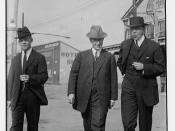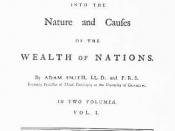The Wealth of Nations was written and published in 1776, and during this time was the beginning of the modern age. New products and ideas were being introduced that are still heavily used today. Manual labor and trade skills were probably the only form of employment and bartering was the only form of business. Many of us today take for granted whatÃÂs available to us in regards to goods and supplies. But in the 18th century there were no grocery stores or hardware stores. The manufacturing of domestic goods fell in the hands of the artisans who spend their entire life learning and perfecting their desired trade.
The main idea in The Wealth of Nations by Adam Smith lies in the notion of economic growth. Throughout the century growth has evolved to new heights, different people had different ways of conducting business. The economic growth, according to Smith is emphasized in the expansion of the division of labour.
ÃÂThe greatest improvement in the productive powers of labourÃÂ (Smith, 3) Essentially, Smith specializes in the concept of the labour force. Smith compared the model of two different manufacturing methods. First, each worker was responsible for all of the 18 tasks involved in producing a pin. The other had each worker performing only 1 or a few of the 18 tasks that go into producing a completed pin. Smith concluded when a worker is specialized in a single job it will produce greater performance. More specifically, breaking down larger jobs into smaller jobs. Each worker becomes a skilled tradesman in his/her respected area of production, therefore increasing his/her efficiency. Smith suggests when workers donÃÂt have to switch between tasks it will save the company time and money. ÃÂThis great increase of the quantity of work which, in consequence of the division of...


